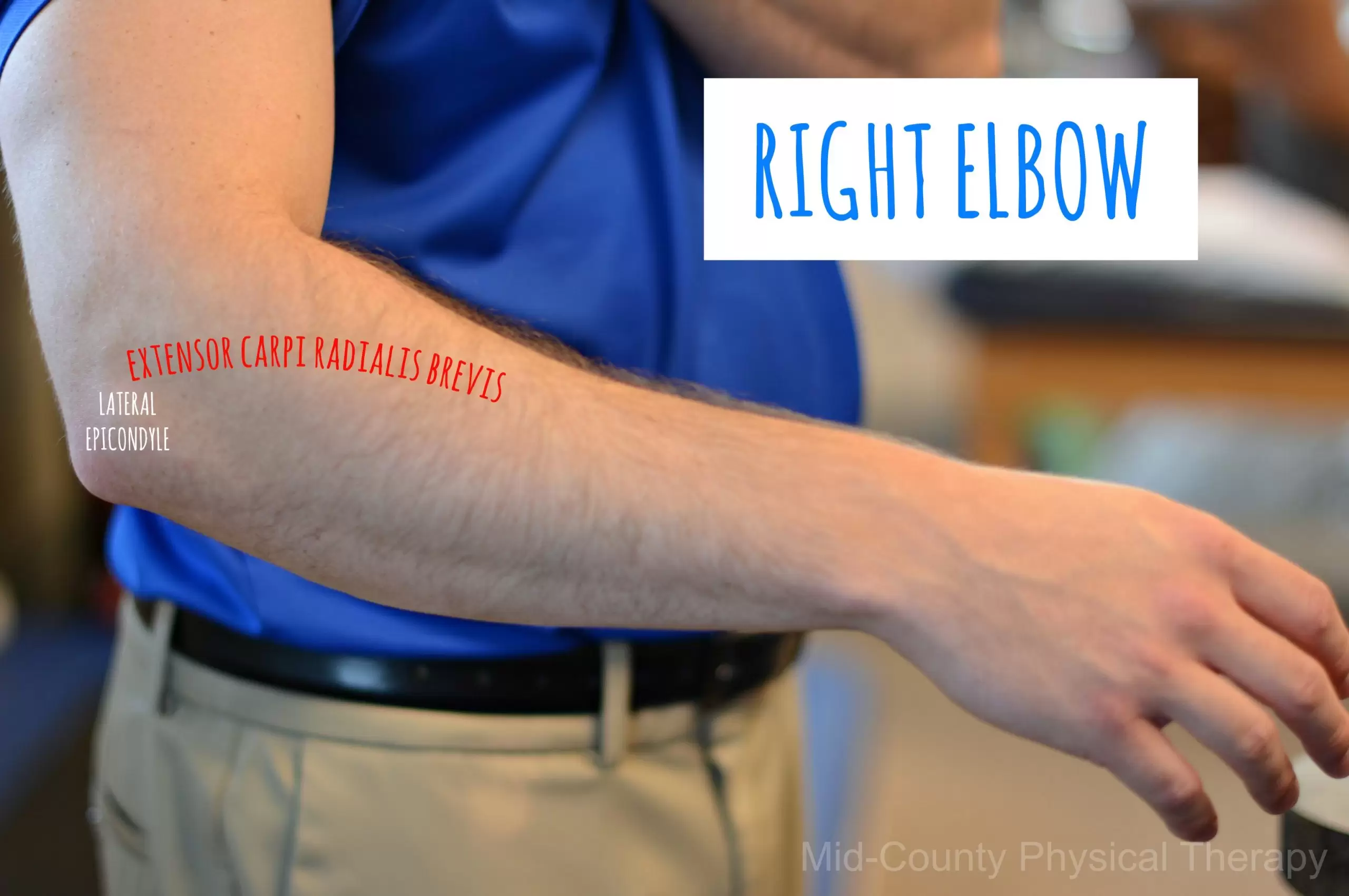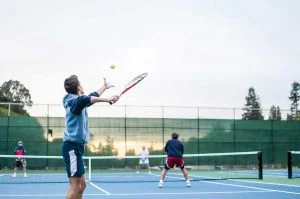Tennis elbow, also known as Lateral Epicondylitis, is a painful overuse injury.
While this injury’s name comes from the prevalence of the injury in tennis players, it is actually more prevalent in individuals that are in the work and manual labor field as well as general athletes.
Tennis elbow refers to the overuse injury and the pain an individual experiences on the outer part of the elbow at the bony landmark called the “epicondyle.” You can feel this landmark, as well as the muscle and tendon attachments. When the tendon that attaches to the epicondyle loses its integrity, the extensor carpi radialis brevis (ECRB; responsible for straightening and stabilizing the wrist), or the main muscle involved, weakens. The signs and symptoms of tennis elbow include:
- Tenderness over the ECRB and the associated tendon
- Pain with activity (grasping, lifting, and gripping items)
- Potential swelling
- Weakened grip strength
Elbow Anatomy
The elbow’s anatomy is made up of the humerus (upper arm bone), radius, and ulna (forearm bones). On the humerus, two main bumps called the epicondyles, protrude. The lateral epicondyle is the main site of concern in tennis elbow. Along with the main bones, there are muscles, ligaments, and tendons that envelop the joint. As stated previously, the ECRB and its respective tendon contribute to the pain.


If you want a more in-depth look, check out this video on the anatomy of the elbow.
How Can You Treat Symptoms?
Some of the remedies to reduce and alleviate symptoms are readily available in your household. Medical professionals everywhere encourage patients to implement the RICE method. RICE stands for:
- Rest: Limit or completely stop the activity that aggravates the knee pain, and switch to low-impact exercises.
- Ice: Without putting ice directly on the skin, apply a cold pack for approximately 20 minutes.
- Compression: Use a compression bandage or a specialized brace (and direction from a professional). This brace wraps around the forearm below the elbow to reduce the stress on the tendon.
- Elevate: This does not always apply to the elbow. When resting, keep the elbow in a neutral position.
NSAIDs, or non-steroidal anti-inflammatory drugs such as ibuprofen, can also provide short-term pain relief. We encourage you to receive an assessment from a physical therapist if the pain continues or increases in intensity.
Other Treatments
There are several other treatment methods that can be beneficial:
- Physical Therapy: Physical therapy for elbow pain provides a thorough evaluation, dictates an exercise and stretching plan, and uses modalities such as electrical stimulation and ultrasounds to decrease the pain. It can also professionally apply Kinesio Tape and focus on your form and how it relates to your injury.
- Steroid injections: This is usually done by your primary care or specialized doctor. They inject the area with an anti-inflammatory medication that can help treat and limit the pain.
- Surgery: This should be your last resort. Consult with your Physical Therapist and Primary Physician about this route.
Research
Another potential treatment that continues to gain steam is the use of platelet-rich plasma. Platelets contain growth factors and can assist with healing the damaged tissues in the elbow. Injections of this platelet-rich plasma have been shown to manage tennis elbow, and are currently in the scope of research and reviews today.
Mid-County Physical Therapy Can Help You
During your one-on-one evaluation with the skilled therapists at Mid-County Physical Therapy, we will get to know you and your physical habits to help establish a foundation for your treatment. We will monitor and document your range of motion, techniques, and current pain level to get a better idea of what we can do for your improvement. Before you receive treatment, it can also be beneficial to document some things such as:
- What movements cause pain?
- When does it begin during activity?
- How long does it last?
- Have your home remedies stopped working?
- Do you want to maintain or improve your current fitness level?
- What are your goals?
Keeping track of this information can be essential for both you and your physical therapist.
Mid-County Physical Therapy also offers a wide variety of treatments to treat and heal your elbow pain. Your condition could improve with a strengthening plan, which the therapist constructs based on your individual experience. The clinic’s open-plan gym includes equipment to suit your strengthening needs while our technicians monitor to encourage proper form and maximum pain relief.
If the therapist determines you may need technique retraining, they will create a personal plan to work individually with you on form and techniques. Our clinic is also proud to offer dry-needling, kinesio taping, and even the BioQPulse. Call or contact us today to learn more about our treatment plans.


